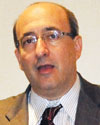The new administrator of the Occupation Safety and Health Administration spoke out earlier this month against measures that lead workers to hide workplace injuries. “Saying you have zero tolerance for injury is crazy,” said David Michaels, who is an assistant secretary of labor. If workers who report injuries are fired, they are not likely to come forward, he said, noting that because of this, “we don’t know what injury rates really are.”

MICHAELS
Michaels spoke at a June 16 construction business forum, co-sponsored by ENR and the Construction Users Roundtable, an owners group. More than 200 construction professionals and owners attended the meeting in Arlington, Va.
The most vulnerable industry workers are Hispanic, according to Michaels. They have a “50% higher injury rate,” with many jobsite injuries resulting from not understanding English, he noted. OSHA “protects all workers, whatever their [immigration] status,” he said.
Michaels reported that OSHA’s Voluntary Protection Program, which allows owners and contractors with excellent safety records to do much of their own compliance, has funding for fiscal year 2010 but could be phased out after Sept. 30. In the agency’s budget proposal for the next fiscal year, it is seeking to shift funding for program-compliance staff to enforcement, said Michaels. “We want to see the program continue but without the resources,” he noted.
Greg Nadeau, deputy administrator of the Federal Highway Administration, noted the agency’s “major innovation initiative” to accelerate deployment of market-ready technologies to speed delivery of bridge and highway projects.
The program, called “Every Day Counts,” reflects the “growing sense that it is taking too long to get projects built,” Nadeau said. The figure “tossed around” is an average of 13 years for a major highway project to move from planning to delivery, he added. “If you promise someone relief from traffic congestion, they don’t want to wait 13 years to get it,” Nadeau pointed out.

NADEAU
After the program’s launch last fall, FHWA gathered ideas from staff and the construction community. The round-one initiatives selected were announced at a recent meeting of the American Association of State Highway and Transportation Officials. On the preconstruction side, FHWA offers a proposal to prepare environmental and other planning documents without duplicating work already done. “The early planning process needs to prepare for the ultimate environmental documents,” Nadeau said. One construction-phase innovation FHWA finds “very promising” is to bring construction manager-at-risk methods to the mostly design-bid-build world of highway contracting, he noted.
Greg Sizemore, CURT executive vice president, told attendees the group has formed a new committee called the Nuclear Construction Effectiveness Council. He noted that the 15 power-sector owners who attended the council’s inaugural meeting and represent about $50 billion worth of construction spending “realize we can’t do nuclear-power construction like we did in the 70s.” The owners are “huddling to see what can be done” to reduce costs and improve project predictability in building major nuclear powerplants, Sizemore added.



